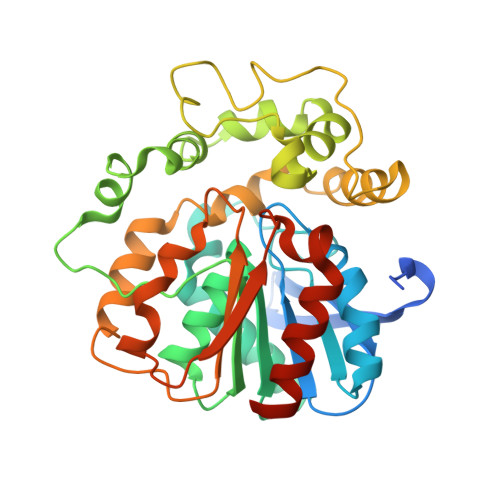15-deoxy-Delta12,14-Prostaglandin J2inhibits human soluble epoxide hydrolase by a dual orthosteric and allosteric mechanism.
Abis, G., Charles, R.L., Kopec, J., Yue, W.W., Atkinson, R.A., Bui, T.T.T., Lynham, S., Popova, S., Sun, Y.B., Fraternali, F., Eaton, P., Conte, M.R.(2019) Commun Biol 2: 188-188
- PubMed: 31123712
- DOI: https://doi.org/10.1038/s42003-019-0426-2
- Primary Citation of Related Structures:
6I5E, 6I5G - PubMed Abstract:
Human soluble epoxide hydrolase (hsEH) is an enzyme responsible for the inactivation of bioactive epoxy fatty acids, and its inhibition is emerging as a promising therapeutical strategy to target hypertension, cardiovascular disease, pain and insulin sensitivity. Here, we uncover the molecular bases of hsEH inhibition mediated by the endogenous 15-deoxy-Δ 12,14 -Prostaglandin J 2 (15d-PGJ 2 ). Our data reveal a dual inhibitory mechanism, whereby hsEH can be inhibited by reversible docking of 15d-PGJ 2 in the catalytic pocket, as well as by covalent locking of the same compound onto cysteine residues C423 and C522, remote to the active site. Biophysical characterisations allied with in silico investigations indicate that the covalent modification of the reactive cysteines may be part of a hitherto undiscovered allosteric regulatory mechanism of the enzyme. This study provides insights into the molecular modes of inhibition of hsEH epoxy-hydrolytic activity and paves the way for the development of new allosteric inhibitors.
- 1Randall Centre for Cell and Molecular Biophysics, School of Basic and Medical Biosciences, King's College London, London, SE1 1UL UK.
Organizational Affiliation:
















